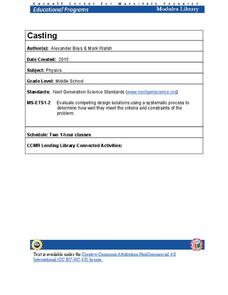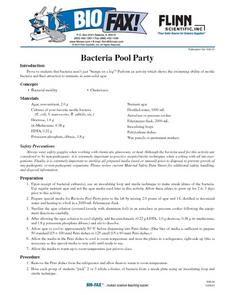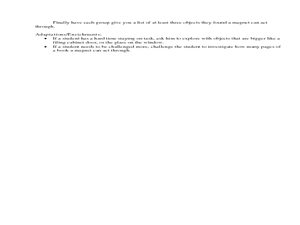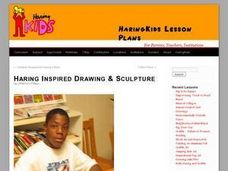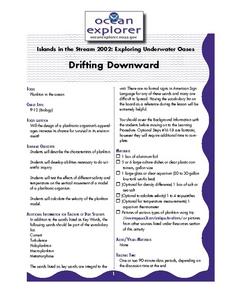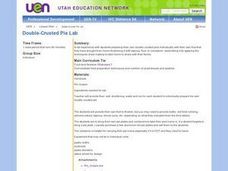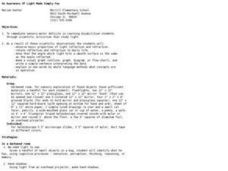NOAA
Make Your Own Volcano!
Make a volcano erupt in your own classroom! Young scientists use household and craft materials to model and simulate the eruption of a volcano.
Cornell University
Casting
Don't cast a great hands-on resource aside! Scholars learn about the process of casting by actually trying out an example. Plaster of Paris and cookie cutter molds help them complete the activity.
It's About Time
Properties of Matter
Never trust an atom; they make up everything! Young chemists make modeling dough and add another ingredient to change the properties. Scholars then compare the properties of emulsion to composite materials. A reading passage and analysis...
PBS
Hidden Alarm
It's time! The fourth lesson in a five-part series has teams of scholars build a circuit for an alarm. A switch lets them turn the alarm on and off and allows them to hide the alarm—just as long as they don't hide it in the classroom!
Curated OER
Electricity
Fourth graders experiment to find out how to light a bulb with simple materials. They make predictions if a light bulb set-up could work and gain knowledge to tell the difference between an open and closed circuit. They also figure out...
Curated OER
The Boy of a Thousand Faces
Students discuss what an illustrator is and illustrations help readers follow the story line. Using the illustrations, they identify the characteristics of facial proportions and draw their own face. They use glue to cover the lines...
Curated OER
Bacteria Pool Party
Students investigate the organisms of bacteria. They are given a culture of bacteria that can be observed under a microscope. The students make observations that are recorded. The lesson includes the mention of specific safety...
Mr. Roughton
Pawn Stars: Africa
What element was worth more during the growth of empires in West Africa: gold or halite? After examining various pieces of evidence of primary and secondary source documents placed around the room, your class members will each make a...
Beyond Benign
Packed Up Properties
Determine physical properties of potential packaging materials. Continuing from previous lessons in the series, the resource asks groups to identify physical properties of the substances. They test for conductivity, solubility, water...
Curated OER
How is heat transferred through conduction?
Fifth graders observe different types of conductors. They answer orally about the conduction of heat energy with 100% accuracy. Students investigate some materials that conduct heat much better than others, and poor conductors can...
Curated OER
Heat: Mini Unit
Students experiment with heat. In this physical science lesson, students engage in hands-on activities to develop concepts related to heat. Students offer explanations for their observations using given vocabulary.
Curated OER
Mined or Grown?
Sixth graders differentiate between raw materials that are cultivated and those that are mined. They collaborate with their eighth grade peers to learn more about the mining complexities at the end of their mineral identification unit.
Curated OER
Exploring Magnets
Second graders experiment with magnets. In this magnet instructional activity, 2nd graders attach a magnet to several different objects to see what it sticks to. They place objects in between a magnet and metal to see if the magnetic...
Curated OER
DNA Transformation of Bacteria-Ampicillin
Students demonstrate how genes can be transferred from one bacteria to another. In this experiment, they take a plasmid with a gene for resistance to the antibiotic ampicillin which is used to transfer the resistance gene into a...
Curated OER
Solar Hot Dog Cooker
Students create a solar hot dog cooker. In this solar energy lesson, students use various materials such as tin foil and cardboard to build a hot dog cooker. Students cook their own hot dogs.
Curated OER
Labs from Chicago, Summer 1993: Calibrating the Sun's Light
Students experiment with the luminosity of the Sun's light. In this luminosity lesson, students participate in an experiment with luminosity of the sun and flashlights. They make filters and fiber optic sources.
Curated OER
Haring Inspired Drawing and Sculpture
Students research art by identifying the work of Keith Haring. In this sculpting lesson, students utilize the web to examine sculptures and drawings in the style of Keith Haring. Students utilize sculpting wire, foil, pencils, glue and...
Curated OER
The Ghost Catcher
Students make a mirror after reading the story The Ghost Catcher. In this The Ghost Catcher lesson plan, students answer comprehension questions and make a mirror out of foil and paper plates.
Curated OER
Drifting Downward
Students study the effects of different salients and temperatures on vertical movement of an organism. In this experimental instructional activity students design different shapes of foil to simulate drifting planktonic organisms.
Curated OER
Double-Crusted Pie Lab
Students individually practice the techniques and skills learned in preparing a double crusted pie using fresh, canned or frozen fruit that needs to be thickened with tapioca, flour or cornstarch.
Curated OER
Pretzel Mania
In this instructional activity, students enhance their number and letter recognition. Students make letters and numbers with pretzel dough. Students prepare the pretzel dough, shape it, bake it, and eat it. In this instructional...
Curated OER
Leyden Jar: Static Electricity
Students experiment with a Leyden Jar, a device that stores electrical charges. A large voltage can be built up in this jar by adding more and more charge. The modern name for this device is a capacitor.
Curated OER
Where in the World is Carbon Dixoide?
Students conduct experiments designed to detect the presence of CO2 by using a BTB that changes color (blue to yellow) in the presence of CO2. First, students experiment with the CO2 from combining vinegar and baking soda. In part two,...
Curated OER
An Awareness of Light Made Simply Fun
Learners with sensory perception issues discover the properties of light through a series of excellent hands on activities. They look at beams of lights in a darkened room; use a kaleidoscope and optical illusions as they experience the...

